25 May 2016
Gothic art in Navarre
Gothic mural painting: Juan Oliver and the School of Pamplona
Dr. Carlos Martínez Álava
Mendillorri Secondary School
Mural painting, in spite of its decisive role in establishing the Gothic spatial reality, has not preserved too many testimonies, neither in Navarre nor in most of the Gothic West. In fact, the Issue of missing works clearly exceeds what has been preserved. We are fortunate that some of the most monumental ensembles (preserved in the Museum of Navarre) nourished the monographic study of Professor Carmen Lacarra, the starting point for any analysis of the period; and that in recent years the Catalog of known works has increased notably thanks to the intervention of neighbors, parish priests and institutions.
We do not know much about the oldest Gothic paintings. Their characteristics around 1200 can be seen in the Bibles of Pamplona, commissioned by Sancho el Fuerte and preserved in Ausburg and Amiens. Their stylized figures, with firm and repetitive strokes, are consistent with the processions of laymen and ecclesiastics who prayed before the Agnus Dei of the apsidal cylinder of San Martín de Artaiz (Museum of Navarre). They date from the first half of the 13th century. On the central window, beautiful and complex vegetal compositions recall another of the fundamental features of the painting of the time: Byzantinism. It probably arrived in Navarre through the influence of the chapterhouse conference room of the Sigena Monastery. And it will be in the parishes of Olite (dependent on Montearagón) where this influence is best observed. The first paintings in the chapel of the Virgin of the Campanal de San Pedro de Olite (Museum of Navarra) stand out, with a Pantocrator, a Coronation of the Virgin, and an Epiphany, among other scenes. With respect to them, those of Santa María, preserved in situ in the manner of a mural pictorial altarpiece, show more local features. Both can be placed late in the second third. Finally, the mural paintings of the central panel of the main chapel of San Saturnino de Artajona (Museum of Navarra), with the Glory of Christ between angels and St. Peter and St. Paul, show a greater variety of types and attitudes, a great chromatic richness, true luxury in the borders and backgrounds, and an unquestionable monumentality. Their chronology seems to be somewhat more advanced, already within the second half of the 13th century.
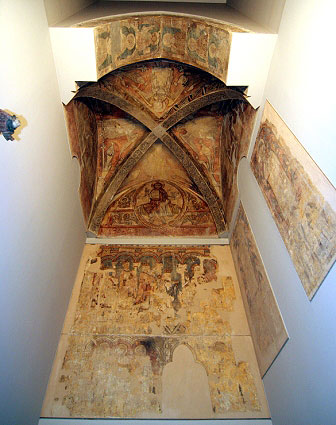
Olite. Parish Church of San Pedro
Chapel of the Virgen del Campanal. General view
Museum of Navarre
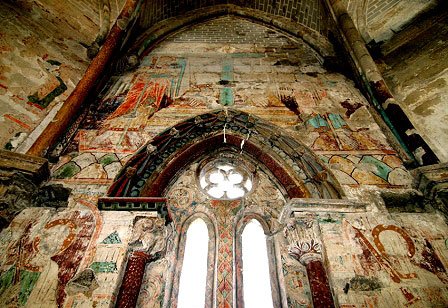
Artajona. Church of San Saturnino. Painting of the central panel of the apse.
The 14th century, especially in its first half, was the period of greatest artistic brilliance in mural painting in the kingdom of Navarre. The work in the cloister and outbuildings of Pamplona Cathedral was a decisive factor in this artistic explosion. What are the main characteristics of the Gothic line painting that was produced at that time? The postures are elegant, the figures stylised, the folds very elaborate, and the colours varied and contrasted; furthermore, the stories, sometimes very complex, are arranged by means of radiating arcades. The key figure of the period was Juan Oliver. He was the starting point and best-known artist of the Pamplona School. Before him, there are no certain chronologies for other groups. We can perhaps place the magnificent paintings of San Salvador de Sangüesa (pending restoration) or the crypt of the parish church of Sos del Rey Católico in the first third of the 14th century.
Juan Oliver appears in the kingdom's documentation in 1332 as a "painter from Pamplona", so we can assume that he had settled in the city before then. The mural in the Refectory of Pamplona Cathedral (Museum of Navarre) is dated three years later. We then have to wait until 1366, when a Johan Oliver lived in the Rúa Mayor del Burgo de San Cernin. His presence in the documentation will be repeated in 1379, 1387 and 1390. Evidently we are dealing with a saga of painters, at least three generations with a workshop in Pamplona. The one we are interested in is the initiator of the saga. He trained in Avignon, where he appears to have worked between 1316 and 1321 under Pierre du Puy. His role in the history of medieval art in Navarre would be fundamental, as he would incorporate the forms, iconographies and techniques that were used in one of the most active European artistic centres during the 14th century. Today, we consider his works to be the mural in the Refectory of Pamplona Cathedral (identified by registration), the head of Christ on the reader's staircase in the same building, the decoration of the main chapel of San Julián de Ororbia, the cycle of Santa Ágata in Olloki and the apse of the Crucifix in Puente la Reina. These are extraordinary works, especially the refectory and Ororbia ensembles, which characterise the work of an artist of international stature who will leave a deep and lasting mark. Less pictorial evidence can be attributed to the master Roque: the side paintings of San Saturnino de Artajona (identified by registration) and, with certain doubts, the funerary arcosolium of Santa María de Ribas and the Azanza paintings. His proximity to Oliver is so great that, with current knowledge, we can assume that he was a disciple of his. Other interesting ensembles can be found in Ujué, the work of Martinet de Sagües (or Sangüesa), in Ekai, in Ardanaz, in Eristáin, in Aizpún, in Belascoáin ... or, in the cathedral cloister itself, with the beautiful, rich and erudite Tree of Jesse.
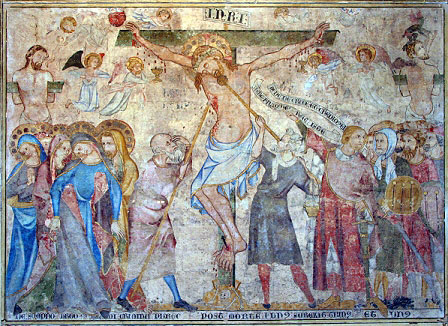
Pamplona. Cathedral.
Altarpiece of the Passion of Christ. Juan Oliver.
(Museum of Navarre)
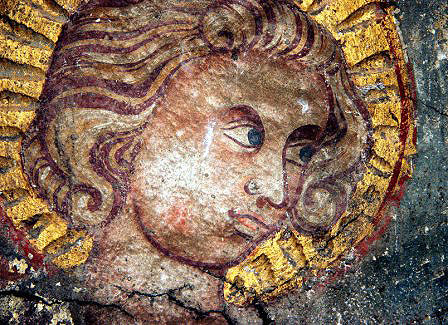
Ororbia. Parish of San Julián
Juan Oliver
Resurrection. Detail
Towards the middle of the century, certain unmistakable traits of Italianate style began to emerge that were to characterise the last brilliant chapters of Gothic mural painting in the kingdom of Navarre. The second paintings in the chapel of the Virgen del Campanal in San Pedro de Olite date from this period, as does the decoration of the tomb of Bishop Sánchez de Asiáin in the cloister of Pamplona cathedral. The figures are stylised and resolved with greater naturalism and, above all, the backgrounds are more elaborate, incorporating complex architectures, trees, mountains... and perimeter borders in imitation of mosaics. Along similar lines, but in a more popular manner, we have the early Gallipienzo paintings and a few fragments in San Nicolás de Pamplona. This will be the epilogue to one of the most brilliant and interesting chapters of Gothic art in the kingdom. And a chapter whose analysis is far from complete, as it is foreseeable that in the coming years new discoveries will complete and enrich an already extraordinary panorama.
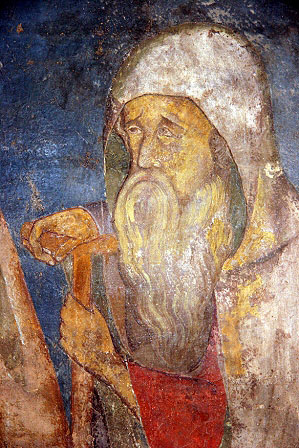
Olite. Parish Church of San Pedro
Chapel of the Virgen de la Campanal. Second master
